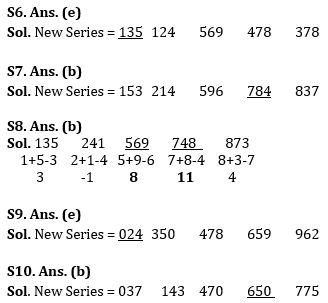Directions (1-5): In these questions, the relationship between different elements is shown in the statements. The statements are followed by two conclusions. Give answer
(a) if only conclusion I is true
(b) if only conclusion II is true
(c) if either conclusion I or II is true
(d) if neither conclusion I nor II is true
(e) if both conclusions I and II are true
Q1. Statements: G ≤ C, B > G, E > A ≥ K, B< K
Conclusions: I. E > C
II. B ≤ C
Q2. Statements: A ≥ K, K< M > N, B ≥ N
Conclusions: I. A > N
II. K < B
Q3. Statements: G > S, M ≥ N > G, R ≥ M
Conclusions: I. G < R
II. S < M
Q4. Statements: N ≥ M < S, R > T < J, N > R
Conclusions: I. S < R
II. S > T
Q5. Statements: B ≤ A < D, C ≥ E, B > C
Conclusions: I. A ≥ E
II. E < A
Directions (6-10): The following questions are based on the five three digits numbers given below:
135 241 569 748 873
Q6. If in each number, all the three digits are arranged in ascending order within the number, then which of the following will be the second lowest number after rearrangement?
(a) 873
(b) 748
(c) None of these
(d) 569
(e) 135
Q7. If second digit will be interchanged with third digit in each number, then which number will be the second highest number after rearrangement?
(a) 873
(b) 748
(c) None of these
(d) 569
(e) 135
Q8. If in each number, both first and third digits are added and after that second digit is subtracted from that addition then how many numbers will give the resultant which is greater than 5 after mentioned operation?
(a) One
(b) Two
(c) Three
(d) Four
(e) None of these
Q9. If in each number, all the odd digit is subtracted by 1 and all even digit is added by 1 then, which of the following will be the lowest number after mentioned operation?
(a) 873
(b) 748
(c) None of these
(d) 569
(e) 135
Q10. If 1 is subtracted from first digit and 2 is added to last digit of each number then, which number will be the 4th lowest number after mentioned operation?
(a) 873
(b) 748
(c) None of these
(d) 569
(e) 135
Solutions
Solutions (1-5):
S1. Ans. (d)
Sol. I. E > C (false)
II. B ≤ C (false)
S2. Ans. (d)
Sol. I. A > N (false)
II. K < B (false)
S3. Ans. (e)
Sol. I. G < R (true)
II. S < M (true)
S4. Ans. (d)
Sol. I. S < R (false)
II. S > T (false)
S5. Ans. (b)
Sol. I. A ≥ E (false)
II. E < A (true)






 GA Capsule for SBI Clerk Mains 2025, Dow...
GA Capsule for SBI Clerk Mains 2025, Dow...
 The Hindu Review October 2022: Download ...
The Hindu Review October 2022: Download ...
 ECGC PO Cut off 2025 Out, Check Final Cu...
ECGC PO Cut off 2025 Out, Check Final Cu...




